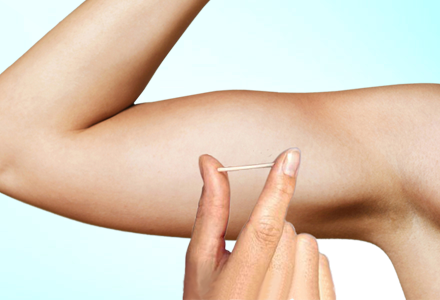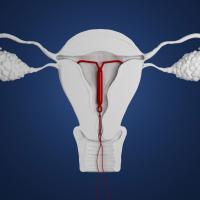Contraceptive Implant (Implanon)
A number of GP's practicing at GHFP are trained in insertion and removal of Implanon.
What is Implanon?
Implanon is a contraceptive rod containing the hormone etonogestrel, which is similar to the naturally occurring hormone progesterone, made by a woman’s ovaries. It is about the size of a match – four centimeters long and two millimeters wide. It is inserted under the skin of the inner upper arm. Once inserted, it can be felt, but not easily seen.
How effective is it?
Implanon is the most effective reversible method of contraception available. It is more than 99.9% effective.
How does it work?
- It stops the body from releasing an ovum (egg) each month.
- It thickens the mucus in the cervix (the entrance to the womb), which blocks sperm.
How do I use Implanon?
Insertion
Implanon must be inserted by a specially trained doctor or nurse. Insertion takes a few minutes, with local anaesthetic used to prevent discomfort. There may be some soreness and bruising, which settles within a few days. Implanon can be left in for up to three years before it needs to be removed or replaced.
Removal
The doctor will inject local anaesthetic under the implant, make a tiny cut in the skin and remove the Implanon rod. This usually takes a few minutes. You will have a small scar, but won’t have any stitches. You can have a new rod inserted at the same site at the same appointment.
When does it start working?
If Implanon is inserted during the first five days of a normal period, the contraceptive effect starts immediately. It can be inserted at other times in your menstrual cycle, in which case it takes seven days to become effective.
What are the advantages of Implanon?
- Implanon is highly effective,
- It provides 3 years of contraception.
- Implanon is inexpensive - the cost of a normal PBS prescription.
- Implanon is usually easily reversible.
- You don’t have to remember to take a pill every day.
- Bleeding may be lighter and less painful or your periods may stop.
- When Implanon is removed, the contraceptive effect and any side effects are quickly reversed.
- It can usually be used if you are unable to use contraception containing oestrogen.
- Your contraception will not be affected if you have diarrhoea or vomiting.
- Implanon is safe to use if you are breastfeeding.
What are the disadvantages of Implanon?
- You may experience pain and bruising in the area where Implanon is inserted.
- Your bleeding pattern will change.
- Bleeding is unpredictable.
- Implanon will not protect you against sexually transmissible infections (STIs). Continue to use condoms.
- Occasionally, women need to be referred to a specialist for removal of the Implanon rod. This is very rare.
Who should not use Implanon?
Women who have had breast cancer within the last five years and women taking certain medications should not use Implanon.
What are the side effects?
- All women given Implanon will experience a change in their bleeding pattern.
- Some will stop having periods completely. This is not harmful.
- Some may have irregular bleeding, which may be frequent and is unpredictable. This often settles in the first three to four months of use.
- Some women will have persistent bleeding or spotting.
- Some experience acne, breast tenderness, moodiness, increased appetite and headaches.
Unless side effects are severe, you should try to keep Implanon in for at least three months, as any side effects will often settle in this time.
Is it for me?
Implanon may be right for you if you:
- want a method that’s ‘fit and forget’
- want the most effective method available (besides sterilisation)
- find it hard to remember to take a tablet every day
- don’t mind some irregular bleeding
- have painful periods
Other things you should know
What if I become pregnant?
- There is no evidence that Implanon can harm a pregnancy.
What if I don’t like Implanon or want to become pregnant?
- Implanon can be removed at any time.
- Unless side effects are severe, you should try to keep Implanon in for at least three months, as any side effects will often settle in this time.
- After removal, any side effects should be reversed within weeks and you should start to ovulate (release eggs) again.
- When you stop using Implanon, you have the same chance of becoming pregnant as you had before you started.
Can I use Implanon while I’m breastfeeding?
- Yes. Implanon is safe to use no matter what age your baby is.
Will I gain weight while using Implanon?
- While some women report weight gain, most women’s weight will not change.
What happens if I have Implanon in for more than three years?
- If you are unable to have your Implanon changed before its three years of use have passed, use condoms until seven days after you have had your Implanon replaced.
Arranging Implanon at GHFP
Please make a Standard Appointment with your GP to:
- Discuss Implanon, and make sure it's the right contraceptive option for you
- Arrange a prescription for Implanon
- Arrange your Insertion Appointment. (We'll try to arrange your Implanon Insertion Appointment to be within the first 5 days of your normal period so that your implanon is effective immediately).
Your Implanon Insertion, Replacement, or Removal Appointment:
- You will need to collect your new Implanon from the Pharmacy, and bring it with you to your appointment.
- Your General Practitioner will discuss the procedure with you.
- A Practice Nurse may assist your General Practitioner with the procedure.
- Your Implanon will be inserted under sterile conditions.
- Your General Practitioner will use local anaesthetic, making the procedure relatively painless.
- You will be provided with a dressing and a bandage, which will help to minimise bruising or bleeding after the procedure.




